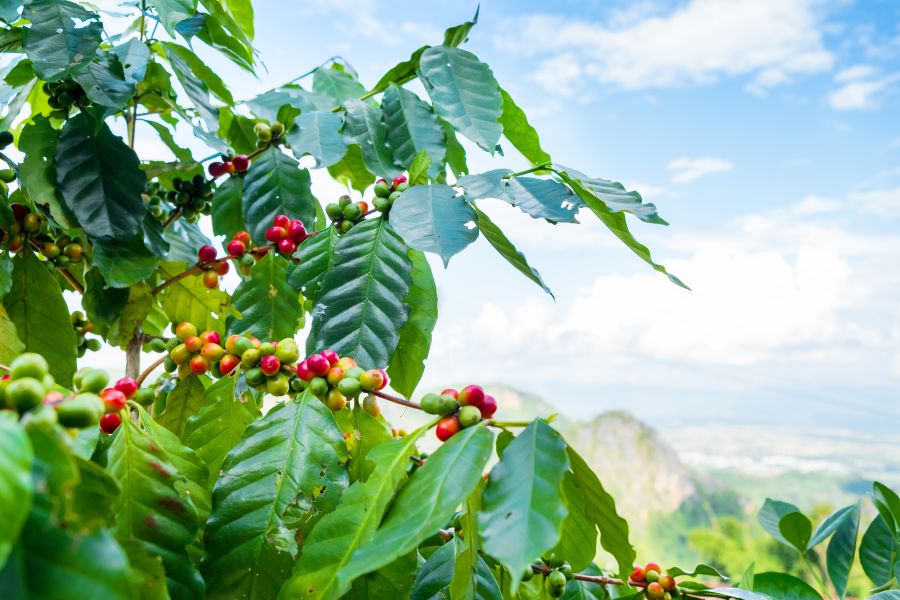ORIGIN OF COFFEE
The coffee plant is an evergreen shrub (the leaves do not fall in autumn) belonging to the Rubiaceae family and the genus Coffeaque. It originates from Ethiopia and is cultivated throughout the tropics.
There are a total of 10 different varieties of coffee plants grown around the world, but the most popular ones are the Coffea Arabiga and Coffea Canéfora coffee varieties.
WHAT IS THE COFFEE TREE LIKE?
As we have explained, coffee does not come from a tree but from a bush, although its trunk is straight and smooth, and in the wild it can grow to a height of 12 to 20 metres! However, in order to be able to grow it comfortably, it is cut to a size of two to four metres to make harvesting easier.
Coffee bushes bear fruit when they are between three and five years old.
Its leaves are bright green all year round, borne in pairs, and between them sprout beautiful white, fragrant flowers, the coffee blossom. They usually have a three-day opening cycle and, on the third day, the fruit is formed.
Over the next eight to eleven months, a small berry will form, called the COFFEE CHERRYThe colour will change from yellow to green and end with a reddish hue.
Inside these cherries are found the COFFEE BEANS we know.
DIFFERENT SPECIES BUT IS THE COFFEE THE SAME?
The answer is no! There are more than 70 coffee tree species different with a wide variety of aromas and flavours of coffeeThe most representative, and at the same time, the most important, are the most important and the most important of these. The most representative and, at the same time, the most important ones are coffee tree species The highest quality are two: Coffea arabica (arabica coffee) and Coffea canefora (robusta coffee).
The arabica coffee cultivation accounts for 55 - 60% of the world's coffee production and 55 - 60% of the world's coffee production. robusta coffee cultivation between 40 - 45% and 1 - 2 % of other coffee varieties.
These percentages tend to vary slightly from year to year due to weather conditions in the production areas, but the cultivation of arabica coffee is usually in the majority.
The coffee plant It needs a lot of humidity to bear fruit and prefers high ground. The species arabica coffee requires more demanding conditions in terms of climate and soil fertility. In optimal situations, the coffee plant can produce COFFEE FRUIT for 50 to 60 years and the yield is 800 to 14000 kg of fruit per hectare.
GEOGRAPHICAL DISTRIBUTION OF COFFEE CULTIVATION
The coffee production is mainly concentrated in the tropics, a 4,000 km band bounded by the Tropic of Cancer above and the Tropic of Capricorn below.
There are about 35 coffee-growing countries in the worldbut the largest volume producers are Brazil, Vietnam, Colombia, Indonesia, Honduras, Ethiopia, India, Mexico, Guatemala, Uganda and Côte d'Ivoire (ICO data). The first seven countries account for 80% of world production.
“El cinturón del café”
“la genética del cafeto afecta al sabor del café”
Con 44 pares de cromosomas que tiene la variedad de cafeto arábica respecto a los 22 pares del robusta coffee, arábica se pone en cabeza con más de 800 aromas y matices diferentes. Esto lleva a la conclusión de que, cuanto más material genético, más variedad de aromas y sabores posee el café.
Y… ¿CÓMO ELIJO ENTRE ARÁBICA Y ROBUSTA?
Aquí te explicamos sus principales diferencias:
Arabica coffee:
- It accounts for 60 - 70% of world production.
- It has a fruity, sweeter taste and more aroma.
- It has a maximum caffeine concentration of 1.7%.
- It is mainly produced in Colombia, Brazil and Ethiopia.
Robusta coffee:
- It accounts for 30-40% of world coffee production.
- It has a stronger, earthy, woody, more bitter taste.
- It has a concentration of 2.5% of caffeine.
- It is produced in Vietnam, Indonesia and Uganda.
¿Tú cuál prefieres?




